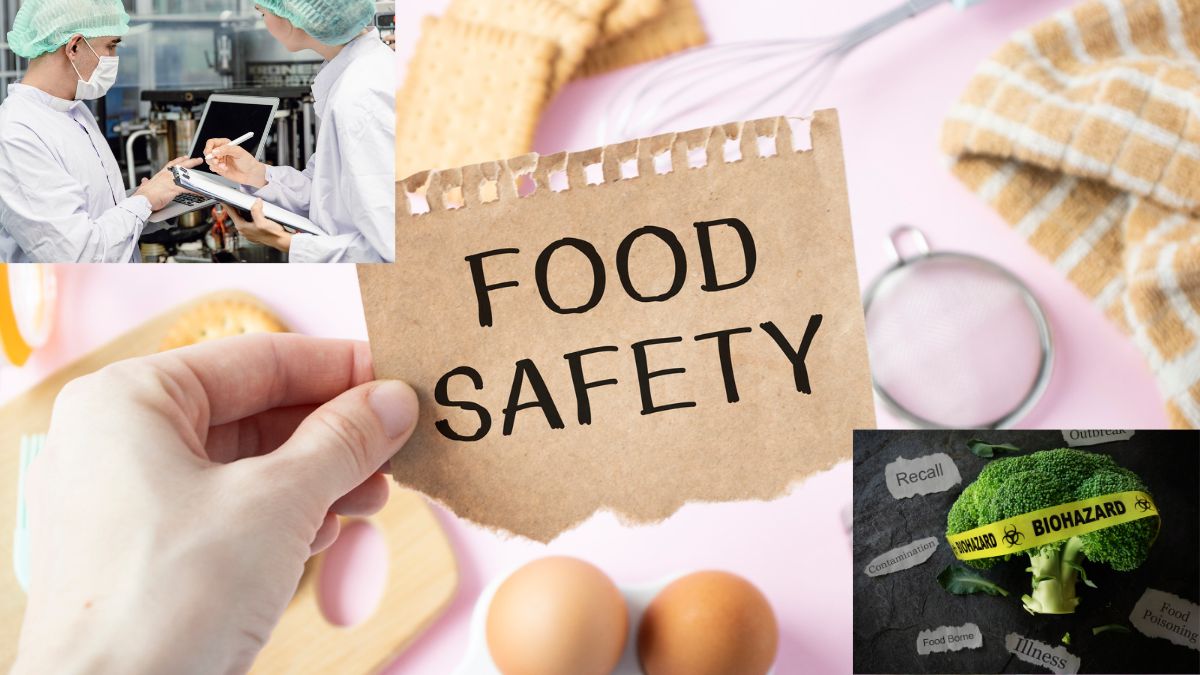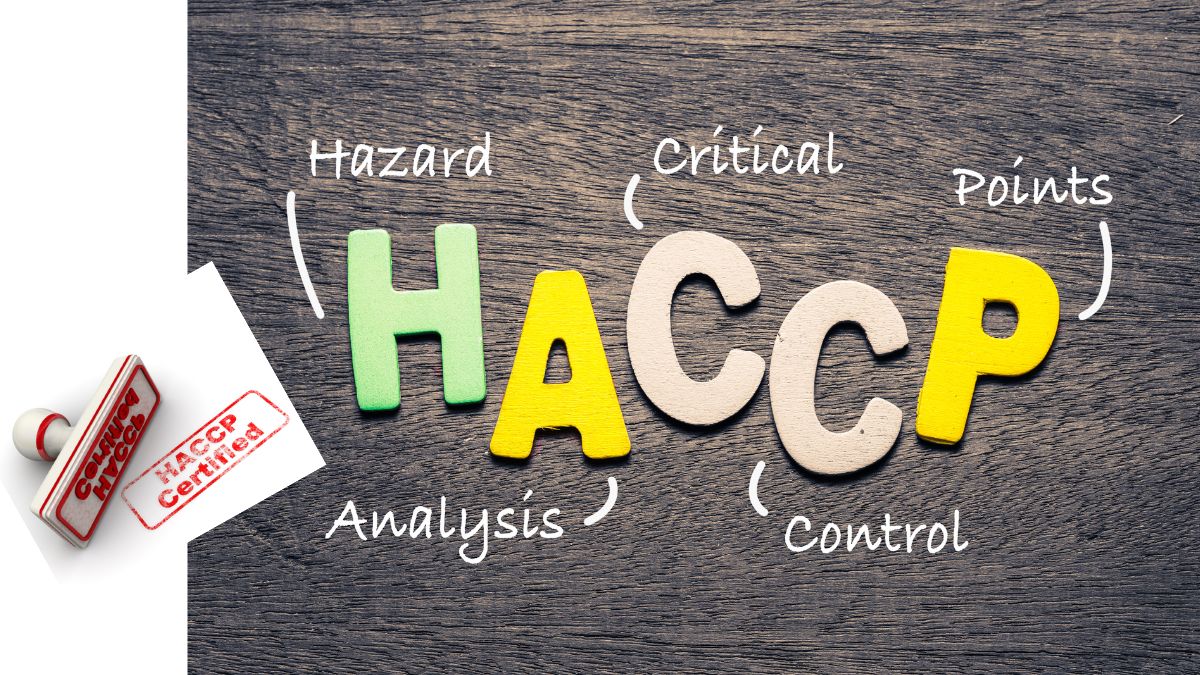The food business must prioritize food safety. It’s critical to make sure that the food we eat is free of dangerous pollutants and bacteria that might infect us and perhaps kill us. The Hazard Analysis and Critical Control Points (HACCP) system is one of the most crucial instruments for guaranteeing food safety. We’ll go over what HACCP is in this post and why it’s crucial for food safety.
What is HACCP?
A methodical methodology known as HACCP is used to recognize, assess, and manage possible risks in the food manufacturing process. It is a management system for food safety that focuses on crucial control points all through the manufacturing process in an effort to avoid foodborne disease. The Pillsbury Corporation and NASA worked together to develop the initial version of the HACCP system in the 1960s. Its initial objective was to guarantee the food safety for astronauts during protracted space journeys.
Nowadays, HACCP is regarded as the best method for ensuring food safety. In order to avoid foodborne disease and adhere to food safety standards, it is utilized by food producers, processors, and distributors all over the world.

What is GMP?
In that they serve as a framework for HACCP implementation, Good Manufacturing Practices (GMP) and Hazard Analysis and Critical Control Points (HACCP) are related concepts. GMPs are a collection of rules and principles that specify the essential conditions for guaranteeing the security and excellence of food items. They include a wide range of subjects, including as product labeling, facility upkeep, personnel cleanliness, and sanitation.
HACCP adoption requires GMP compliance because HACCP builds on GMPs by offering a systematic method for detecting and mitigating risks in the manufacturing process. In other words, whereas HACCP offers a more rigorous and systematic method to detecting and mitigating risks, GMPs provide the fundamental basis for maintaining food safety. Food companies may guarantee the quality and safety of their goods as well as satisfy regulatory requirements by adhering to GMPs and HACCP.
The seven principles of HACCP:
The HACCP system is based on seven principles that are used to identify and control potential hazards in the food production process. These principles are:
- Conduct a hazard analysis: The first step in the HACCP process is to conduct a hazard analysis. This involves identifying all potential hazards in the production process, including physical, chemical, and biological hazards.
- Determine the critical control points (CCPs): Finding the essential control points is the next step once the dangers have been identified (CCPs). CCPs are places in the production process where a risk may be avoided, removed, or diminished to a manageable level.
- Establish critical limits: Following the identification of the CCPs, critical limitations are defined for each CCP. There are certain requirements that must be fulfilled to guarantee that a danger is under control.
- Establish monitoring procedures: In order to make sure that key limitations are being met at each CCP, monitoring measures are put in place. This entails routinely ensuring that dangers are being managed and that the process is under control.
- Establish corrective actions: Corrective measures must be implemented if a departure from a critical limit is found. By taking these steps, the process will be brought back under control and a hazard will not materialize.
- Establish verification procedures: In order to make sure that the HACCP system is operating efficiently, verification processes are put in place. This entails routinely ensuring that dangers are being controlled and that the system is being applied appropriately.
- Establish record-keeping and documentation procedures: Record-keeping and documentation processes are implemented to guarantee that the HACCP system is correctly documented and that records of all monitoring, corrective actions, and verification activities are retained.
Why is HACCP important for food safety?
HACCP is critical for food safety because it is a proactive approach that focuses on avoiding foodborne disease rather than responding to it after it has occurred. HACCP helps to assure food safety by detecting possible risks in the manufacturing process and taking actions to control them. This is especially crucial considering the seriousness of the consequences of foodborne disease, which can range from minor discomfort to serious sickness or even death.
In addition to reducing foodborne illness, HACCP is critical for adhering to food safety requirements. Food safety legislation in many nations require food producers, processors, and distributors to establish a HACCP system. Failing to comply with these standards can result in penalties, product recalls, and reputational harm.
What are the benefits of implementing a HACCP system?
Using a Hazard Analysis and Critical Control Points (HACCP) system in a food manufacturing process has several important advantages. Among the many advantages are:
- Improved food safety: The main advantage of applying HACCP is increased food safety. HACCP aims to avoid foodborne disease and safeguard customers by detecting and managing possible risks throughout the manufacturing process.
- Compliance with regulations: Many nations have laws requiring food producers and processors to have a HACCP system. Companies may assure compliance with these laws and avoid costly fines or other penalties by employing a HACCP system.
- Reduced risk of product recalls: Product recalls may be costly and detrimental to a company’s brand as a result of food safety problems. Companies may lower the risk of food safety events and the possibility of product recalls by establishing a HACCP system.
- Increased efficiency: HACCP can assist to simplify operations and decrease waste by detecting and mitigating possible risks in the manufacturing process. This might lead to enhanced efficiency and cost savings for the business.
- Improved product quality: HACCP may also aid in the improvement of product quality by ensuring that items are manufactured under controlled conditions and fulfill defined requirements.
- Enhanced customer confidence: Companies who employ a HACCP system exhibit their dedication to delivering safe and high-quality products. This may boost client confidence and loyalty, as well as assist the organization develop a great reputation.
In general, putting in place a HACCP system is a proactive approach to assuring food safety and quality. It may give several benefits to food firms, such as greater compliance, decreased risk of recalls, higher efficiency, and increased consumer confidence.

Related: How to Properly Store Apples for Long-Term Freshness In 4 Steps?
How is HACCP different from traditional food safety programs?
Hazard Analysis and Critical Control Points (HACCP) is a proactive food safety method that varies from standard food safety programs in key areas.
- Focus on prevention: Conventional food safety initiatives frequently concentrate on discovering and resolving issues after they have occurred. HACCP, on the other hand, is a proactive method that aims to detect and manage possible hazards before they cause harm.
- Science-based approach: HACCP is a science-based strategy that entails a systematic investigation of the manufacturing process in order to identify possible hazards and establish control measures. Anecdotal evidence or established procedures may be more important in traditional food safety initiatives.
- Customization: HACCP is a personalized approach to the individual demands and features of a manufacturing process. Conventional food safety systems may be more uniform and may fail to account for the unique hazards and limitations of a certain process.
- Emphasis on critical control points: HACCP pinpoints critical control points (CCPs) in the manufacturing process where possible risks may be mitigated. Conventional food safety systems may not place as much emphasis on recognizing and managing CCPs.
- Ongoing monitoring and verification: To guarantee that the control mechanisms are successful, HACCP needs constant monitoring and verification. Conventional food safety strategies may not place as much focus on continuous monitoring and verification.
HACCP is a proactive and tailored approach to food safety that differs from typical food safety procedures. HACCP can assist to detect and manage possible hazards before they cause harm to consumers by concentrating on prevention, employing a science-based approach, and identifying crucial control points.
Who is responsible for implementing a HACCP system?
The food producer or processor is responsible for implementing a Hazard Analysis and Critical Control Points (HACCP) system. In other words, any business that manufactures, processes, or handles food must have a HACCP system to assure the safety of their goods.
This comprises the entire food supply chain, from farm to table. While regulatory organizations can give direction and monitoring, the food producer or processor is ultimately responsible for adopting a HACCP system.
Companies who use a HACCP system demonstrate their dedication to creating safe and high-quality products, as well as helping to safeguard consumers from foodborne disease. Companies must take this obligation seriously and ensure that they have a solid and functional HACCP system in place.
Related: Aeroponic Gardening 101: Be An Aeroponic Expert
Conclusion:
Finally, HACCP is a systematic approach to food safety that is largely accepted as the most effective strategy to reduce foodborne disease. HACCP assists in identifying and controlling possible risks throughout the food production process by concentrating on essential control points. The seven HACCP principles provide a framework for food producers, processors, and distributors to develop a food safety management system that fulfills legal standards and assures the safety of their goods.
HACCP is critical not just for protecting customers from foodborne disease, but also for the whole food sector. Food safety events can result in major financial losses as well as reputational harm to a firm. Companies may lower the risk of food safety accidents and demonstrate their commitment to creating safe and high-quality goods by establishing a HACCP system.
HACCP is utilized in other areas where safety is crucial, such as pharmaceuticals and cosmetics, in addition to the food business. HACCP concepts may be used to a variety of businesses and processes to guarantee that possible risks are recognized and managed.
HACCP is an essential technique for guaranteeing food safety and avoiding foodborne disease. It takes a proactive approach to detecting and mitigating possible risks in the food production process, and its concepts may be extended to maintain safety in other essential operations across sectors. Businesses that use a HACCP system demonstrate their dedication to creating safe and high-quality goods, and customers may have trust in the food they eat.
How often should a HACCP plan be reviewed and updated?
A Hazard Analysis and Critical Control Points (HACCP) strategy must be reviewed and updated on a regular basis to ensure that it remains successful in controlling possible hazards and providing safe food products.
The frequency of review and updating may vary based on the complexity of the manufacturing process, changes in equipment or ingredients, and other variables affecting food safety. HACCP plans should, however, be evaluated at least once a year or if there are major changes in the manufacturing process.
Businesses may also need to revise their HACCP plans if new risks are discovered or regulatory requirements change. Companies may guarantee that they are using the most up-to-date knowledge and best practices to create safe food products by evaluating and updating their HACCP plans on a regular basis. This protects consumers from foodborne disease while also demonstrating a commitment to quality and safety.
What are the consequences of not implementing a HACCP system?
Failure to adopt a Hazard Analysis and Critical Control Points (HACCP) system can have major ramifications for both food producers and consumers. Without a HACCP system, potential risks in the manufacturing process may be undiscovered and unregulated, increasing the risk of foodborne illness.
This can have a severe impact on customers’ health, as well as damage to a company’s brand and financial losses due to recalls and legal action. Moreover, regulatory organizations may levy fines or other penalties on businesses that fail to adopt or comply with HACCP regulations.
Companies that fail to establish a HACCP system endanger not just customers but also their own success and survival. Food producers must take their duty to guarantee food safety seriously by adopting a HACCP system and adhering to all relevant legislation and criteria.
What is the cost of implementing and operating HACCP?
Many food manufacturers are concerned about the time and resources required to implement and operate a Hazard Analysis and Critical Control Points (HACCP) system.
HACCP costs may include charges for personnel training, equipment upgrades or adjustments, record-keeping, and other operational expenses. Although there may be some early expenses connected with installing a HACCP system, the long-term advantages can greatly surpass the original expenditure.
Companies may lower the risk of foodborne disease, protect consumers, and improve their reputation for quality and safety by establishing a HACCP system. Moreover, HACCP compliance may be a legal or regulatory obligation, and failure to comply may result in fines or other consequences.
Finally, the cost of developing and managing a HACCP system is a tiny price to pay for the benefits of producing safe, high-quality food items while adhering to all applicable rules and criteria.
Can HACCP be used for small-scale food production?
Yes, Hazard Analysis and Critical Control Points (HACCP) can be used for small-scale food production. In fact, HACCP is a versatile system that can be tailored to the size and complexity of any food manufacturing business, no matter how large or little. While HACCP was designed for large-scale food manufacturers, it has now been adapted to smaller enterprises such as small-scale processors and even home-based companies.
The objective is to design the HACCP plan to the individual demands and hazards of the operation, taking into account elements such as product type, manufacturing method, and available resources. Small-scale food producers may enhance the safety and quality of their goods, minimize the risk of foodborne disease, and demonstrate a commitment to providing safe food by establishing a HACCP system.


